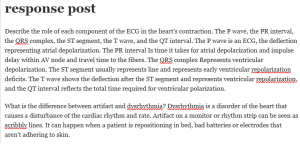response post

Describe the role of each component of the ECG in the heart’s contraction. The P wave, the PR interval, the QRS complex, the ST segment, the T wave, and the QT interval. The P wave is an ECG, the deflection representing atrial depolarization. The PR interval Is time it takes for atrial depolarization and impulse delay within AV node and travel time to the fibers. The QRS complex Represents ventricular depolarization. The ST segment usually represents line and represents early ventricular repolarization deficits. The T wave shows the deflection after the ST segment and represents ventricular repolarization, and the QT interval reflects the total time required for ventricular polarization.
What is the difference between artifact and dysrhythmia? Dysrhythmia is a disorder of the heart that causes a disturbance of the cardiac rhythm and rate. Artifact on a monitor or rhythm strip can be seen as scribbly lines. It can happen when a patient is repositioning in bed, bad batteries or electrodes that aren’t adhering to skin.
How can you reduce artifacts? What are some situations that can occur if artifact is not reduced or eliminated?
Ensure the leads are placed properly, remove hair if needed, check cords for kinks when hourly rounding, change batteries before the last bar, remind the patient that they are wearing it in case of confusion.
You are working in the Telemetry Unit. The nurse “watching” the monitors is reading a magazine. She constantly turns off an alarm that looks a lot like Ventricular Fibrillation. She tells you that it is not a dysrhythmia, it is just artifact. What do you think about her actions? What is the worst-case scenario in this situation? What would you do?
Sadly,
this is seen a lot in healthcare. I would remind her that she is the nurse and if something does happen i will report her no hesitation. I honestly would go check on the patient to make sure they are okay. Not their fault there is staff on their care team that doesn’t wish to assist. It always better to be safe than sorry.
2.
P wave: In an ECG, the deflection representing atrial depolarization
PR interval: Represents the time required for atrial depolarization, the impulse delay in the AV node, and the travel time to the Purkinje fibers.
QRS complex: Represents ventricular depolarization
ST segment: Normally an isoelectric line and represents early ventricular repolarization
T wave: The deflection that follows the ST segment and represents ventricular repolarization
QT interval: Represents the total time required for ventricular depolarization and repolarization
What is the difference between artifact and dysrhythmia?
Artifact is the interference seen on the monitor or rhythm strip, which may look like a wandering or fuzzy baseline; can be caused by patient movement, loss of defective electrodes, improper grounding, or faulty equipment. Dysrhythmia is a disorder of the heartbeat involving a disturbance in cardiac rhythm.
How can you reduce artifacts?
-Perform good skin preparation
-Ensure the patient is comfortable and relaxed during the test
-Use high-quality ECG electrodes
-Ensure correct lead wire positioning
-Clean your crocodile clips
-Check the patient cable and lead wires
-Check for AC interference
You are working in the Telemetry Unit. The nurse “watching” the monitors is reading a magazine. She constantly turns off an alarm that looks a lot like Ventricular Fibrillation. She tells you that it is not a dysrhythmia, it is just artifact. What do you think about her actions? What is the worst case scenario in this situation? What would you do?
In my opinion, the nurse has become lazy and very neglectful to the patient and needs to be re educated on her job duties. My initial action is to report the nurse due to the fact that if ventricular fibrillation is ignored or goes untreated it could lead to the death of the patient.